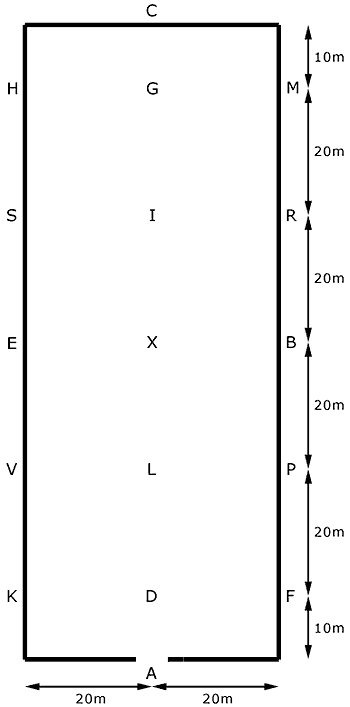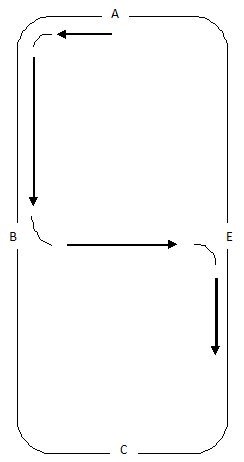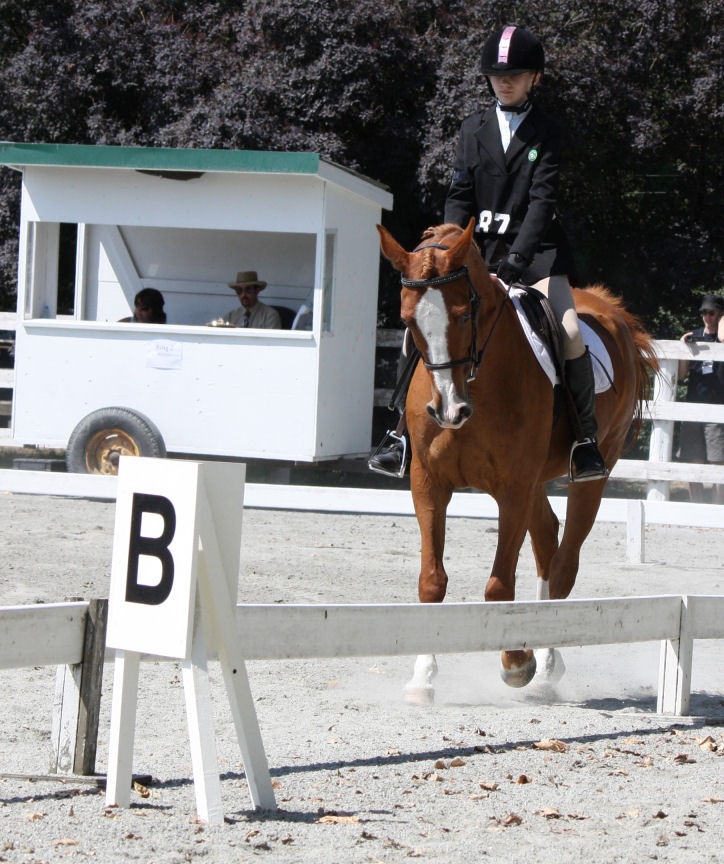Take a lesson at almost any riding school and you will hear a stream of letters flowing past: "twenty metre circle at C", "between K and A develop working canter", "change rein FXH" and so on. These letters are not acronyms or arcane code, but simply markers on the dressage arena.
No one seems to know for sure why the letters refuse to follow in alphabetic order, or why some are missing altogether, but most people blame it on the Germans. At any rate, these letters have been in use in their current places since at least the 1920's so they are probably here to stay.
For the average rider it's not necessary to remember all 17 letters of the 20x60m dressage arena. The important ones in a riding school are A and C on the opposite ends of the arena, B and E on the half-way points of the long sides, F, M, H and K near the corners, and X, which is never marked, but is the centre of the arena.
Letters provide your instructor an easy way of communicating where she wants you to go, but they also provide you an opportunity to test the accuracy of your riding. If you are asked to halt at the letter K, that letter should end up between your horse's shoulder and your leg once you are stopped: not near the nose or tail.
The first test of accuracy we give you in Riding level 1 is:
6. Ride across the school at walk (B to E or E to B)
It sounds simple enough: ride a straight line from B, through X, to E. But remember that straightness comes near the top of the dressage pyramid and is more difficult than it seems.
Riding across the ring from B to E is most often used as a way of changing direction, or rein. In the diagram below the rider is starting on the left rein (ie, the left hand is nearer the inside of the arena) and ends up on the right rein.
It is impossible for a horse, with his long body, to make an absolutely square turn, but the idea is to make the corners as square as possible. Common errors are bulging out past B (ie, preparing the turn too late) and cutting the corner (turning too soon).
To ride the figure correctly:
- Half halt your horse just before B, flexing him slightly to the left, or inside.
- Use your inside leg and outside rein to keep him on the rail until his nose is at B
- Look across the arena to E. Your eyes and head are vital in steering your horse
- Use your left rein and right leg to bend him around your inside leg.
- As he completes the first turn allow him to straighten and ride directly to E
- Repeat all the above steps with the opposite aids (flex right, support with right leg and left rein, etc)
Although it may seem dull to practise such a basic figure it is worth taking the time to perfect the aids at the walk. Only once you have honed your accuracy at the walk can you hope to be accurate at the trot, canter or gallop.
Cavaliere this month
Weekly Mounted Games Practice continues on Fridays from 4-7pm at Red Colt. This is an excellent chance to hone your skills for the August 26th tournament. The cost for using a school horse is $35 (apprentice rates apply); the practices are free if you own or lease your horse.
Mounted Games Tournament
Sunday August 26th, 10am - 4pm
Mark your calendars and start practising your ring-spearing!
